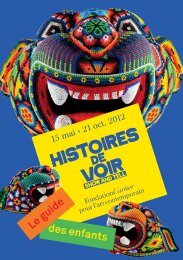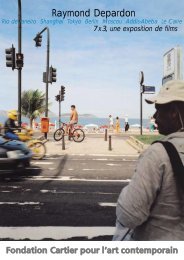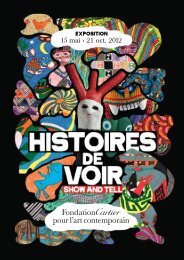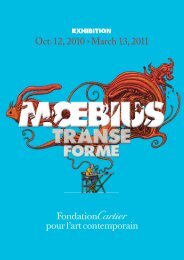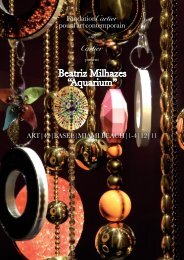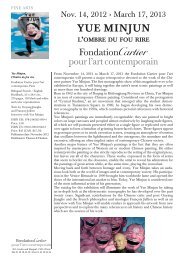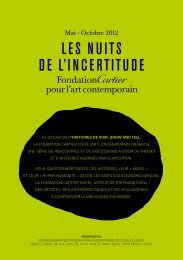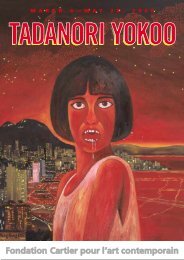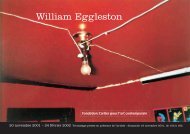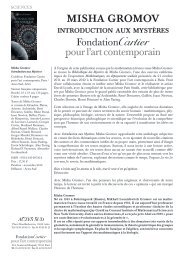March 11 ? Sept. 12, 2010 - Fondation Cartier pour l'art ...
March 11 ? Sept. 12, 2010 - Fondation Cartier pour l'art ...
March 11 ? Sept. 12, 2010 - Fondation Cartier pour l'art ...
Create successful ePaper yourself
Turn your PDF publications into a flip-book with our unique Google optimized e-Paper software.
<strong>March</strong> <strong>11</strong> › <strong>Sept</strong>. <strong>12</strong>, <strong>2010</strong>
EXHIBITION MARCH <strong>11</strong> > SEPT. <strong>12</strong>, <strong>2010</strong><br />
BEAT TAKESHI KITANO<br />
GOSSE DE PEINTRE<br />
—<br />
With joy, humor and seriousness, Beat Takeshi Kitano has thrown himself<br />
into Gosse de peintre, an unusual project that subtly, if impertinently,<br />
alights in the realm of childhood. Entirely created by Beat Takeshi Kitano,<br />
this site-specific exhibition for the <strong>Fondation</strong> <strong>Cartier</strong> <strong>pour</strong> l’art contemporain<br />
will be presented from <strong>March</strong> <strong>11</strong> to <strong>Sept</strong>ember <strong>12</strong>, <strong>2010</strong>. With paintings<br />
and videos, bizarre objects and settings, whimsical and fantastic machines,<br />
Kitano leads the visitor through surprises, gags and games, all the while<br />
mocking contemporary art, experimenting with the sciences and toying with<br />
clichés associated with his country, Japan.<br />
A SingulAr PerSonAlity Filmmaker, actor, TV presenter,<br />
comedian, painter, writer, Takeshi Kitano, also known as Beat<br />
Takeshi, is a singular personality. Famous throughout the world<br />
for his films, Beat Takeshi Kitano commands an unequalled<br />
popularity in Japan as a comic and TV celebrity. Irrepressibly<br />
curious, passionate about the acquisition and passing on of<br />
knowledge, he adroitly switches genres and idioms, moving<br />
from violence to comedy, from over-the-top performances to<br />
deeply restrained ones.<br />
An invitAtion from the fondAtion CArtier While this<br />
insatiable artist finds inspiration everywhere, two leitmotifs<br />
occur frequently in his work: his fascination and nostalgia<br />
for childhood, and his relationship with the image, which is<br />
fundamental to his creative approach. This passion for the<br />
image is also evidenced by a prolific output of paintings, many<br />
of which appear in his films. Reluctant to institutionalize his<br />
artwork, which he deems essentially a private endeavor, Kitano<br />
has never submitted to the numerous requests of museums<br />
to exhibit his work. His decision to accept the <strong>Fondation</strong><br />
<strong>Cartier</strong>’s invitation resulted from meeting with its director,<br />
Hervé Chandès, and their numerous discussions during which<br />
arose the idea of a site-specific exhibition geared toward children,<br />
designed as one gigantic installation.<br />
A multifACeted ProjeCt In creating Gosse de peintre, a<br />
multifaceted project with clear autobiographical references,<br />
Beat Takeshi Kitano subverts the very idea of an exhibition.<br />
He has transformed the museum into an amusement park<br />
in which all the worlds of Beat Takeshi Kitano take center<br />
stage. Popular culture and scientific inquiry, the imaginary<br />
and the satirical, tradition and education, the beautiful and<br />
the kitsch, all co-exist in a setting that is at once diverse<br />
and cohesive.<br />
Meandering along a path studded with bizarre images, interactive<br />
workshops, gags and games, visitors enter a universe<br />
1<br />
as joyful as it is rich and complex. Populated by imaginary animals<br />
amidst an array of inventions, sideshows and musings,<br />
Beat Takeshi Kitano’s exhibition is like a gigantic self-portrait,<br />
an expression of his dreams, ideas, and fantasies both as a child<br />
and an adult. The autobiographical nature of the exhibition<br />
is demonstrated through references to his childhood and<br />
hints to events in his life and even his name, which appears<br />
on objects and within the exhibition decor.<br />
This first exhibition of Beat Takeshi Kitano is one of the most<br />
ambitious projects ever created for the <strong>Fondation</strong> <strong>Cartier</strong>.<br />
It is designed for children, but speaks to adults. With Gosse<br />
de peintre, Beat Takeshi Kitano takes children seriously and<br />
invites them to think, to dream and to join the show.<br />
—<br />
ACtivitieS for Children<br />
<strong>March</strong> > <strong>Sept</strong>. <strong>2010</strong><br />
In the context of the exhibition Beat Takeshi Kitano, Gosse de peintre,<br />
the <strong>Fondation</strong> <strong>Cartier</strong> <strong>pour</strong> l’art contemporain invites young visitors<br />
to discover today’s art in new ways. Workshops and guided tours<br />
for children and families are offered to the public<br />
on Wednesday and Saturday afternoons.<br />
For further information: fondation.cartier.com/enfants<br />
Practical information. Admission: 7 €. Advance booking essential.<br />
Visitors’ Department: Tel. + 33 (0)1 42 18 56 67<br />
info.reservation@fondation.cartier.com<br />
—<br />
exhibition<br />
FONDATION CARTIER POuR l’ART CONTEMPORAIN<br />
General Director: Hervé Chandès / Curator: Isabelle Gaudefroy /<br />
Production Manager: Camille Chenet; intern: Alexandra Fouillade-Meyer /<br />
Production and Installation Coordinator: Christophe Morizot /<br />
Interpreter: Asuka Abe / Registrar: Corinne Bocquet,<br />
Alanna Minta Jordan; intern: Flora Katz / Installation: Gilles Gioan /<br />
lighting: Nicolas Tauveron / Soundtracks: Cristián Sotomayor /<br />
Sound Technician: Cyril Chiron<br />
OFFICE KITANO<br />
General Director: Masayuki Mori / Production Managers: Makoto Kakurai,<br />
Aya Nakahashi, Jun Ogawa / Director of Production: Satoru Maruyama<br />
(ACS Inc.) / Director of Exhibition Design: Hironori Takamatsu (ACS Inc.)
INSTAllATIONS / PAINTINGS / VIDEOS<br />
THE EXHIBITION<br />
—<br />
Described by Kitano as a “series<br />
of dreams,” the exhibition allows<br />
the discovery of a collection<br />
of objects born straight from his<br />
imagination. The entire ground<br />
floor is surmounted by three large<br />
rings that support some two<br />
hundred figurines called dharma,<br />
who seem to be looking over<br />
the visitors and the exhibition.<br />
Very popular in Japan, these<br />
lucky charms are named after<br />
the founder of Zen, Bodhidharma<br />
who, having meditated for<br />
nine years while facing a wall,<br />
saw his legs and arms atrophy.<br />
Conventionally, these Japanese<br />
figurines are red and their<br />
eyes remain unpainted, allowing<br />
those who buy the charms<br />
first to make a wish while<br />
painting the left eye and once<br />
the wish is granted, finish<br />
by painting the right eye.<br />
upon entering the small gallery,<br />
the visitor is greeted by a model<br />
of Beat Takeshi Kitano which is<br />
observing his own brain and is<br />
engaged in an internal dialogue:<br />
Who are You Who is Looking<br />
at Me?! This “self-portrait with<br />
brain” hints at the spirit of the<br />
exhibition, a veritable journey<br />
into the heart of Kitano’s<br />
imaginary world.<br />
Following his 1994 motorcycle<br />
accident, Kitano refused to have<br />
a craniotomy.<br />
“It’s true that if my surgeon<br />
sees these paintings, he’ll probably<br />
think he should have operated<br />
on me right away!”<br />
Beat Takeshi Kitano<br />
In the same room, a recalcitrant<br />
criminal escapes hanging (Beat<br />
Takeshi Kitano’s way of taking on<br />
the death penalty which remains<br />
in force in Japan). A preview of the<br />
latest model of the “safest driver’s<br />
seat on the planet” is also on display.<br />
2<br />
On the small stage of the Ô-Edo<br />
Puppet Theater, a wild array<br />
of Japanese masks—traditional<br />
figures from kabuki theater, folk<br />
characters, deities from Japanese<br />
mythology—create a beguiling,<br />
emblematic composition.<br />
The term Ô-Edo refers to<br />
the name of Tokyo during<br />
the Edo period (1600-1868).<br />
Continuing, the visitor comes upon<br />
Kitano’s theory on the disappearance<br />
of the dinosaurs, as well as the<br />
Japanese Imperial Army’s secret plans<br />
to transform animals into weapons.<br />
Seventeen never-before-seen<br />
creatures, along with the blueprints<br />
that served to make them, are<br />
displayed in a large showcase<br />
fashioned after the façade of<br />
the early-20th-century Japanese<br />
Naval Ministry building.
“Making such comparisons<br />
between machines and animals<br />
is like a children’s game,<br />
but there is also a serious<br />
analytical component to it.[…]<br />
These pictures may seem<br />
funny and can make us laugh.<br />
But quite seriously, a whale<br />
is much better in the water<br />
than a hydroplane.<br />
A dragonfly can fly better<br />
than a helicopter. All of these<br />
man-made technologies are<br />
inspired by living creatures,<br />
but they can never equal them.”<br />
Beat Takeshi Kitano<br />
Grandly seated in the middle of<br />
the room, a gigantic, clattering,<br />
laughably inefficient sewing machine<br />
serves as an ironic metaphor<br />
for contemporary art.<br />
The Kitano Sewing<br />
Machine “Hideyoshi”:<br />
Toyotomi Hideyoshi<br />
is the name of a 16th-century<br />
Japanese warlord who<br />
unified the country following<br />
a century of upheaval.<br />
Right beside this, transgenically<br />
bred fish pre-stuffed with sushi<br />
poke fun at technological progress.<br />
underscoring his respect for traditional<br />
craftmanship, Kitano entrusted<br />
the production of the fish to Hagi<br />
ceramists whose expertise dates<br />
back to the 17th-century. A truly<br />
miraculous catch, the installation<br />
is decorated with a flag, like those<br />
flown by fishermen to ensure a good<br />
catch. He has set afloat “Takeshi’s<br />
Boat” affiliated with the “Fishermen’s<br />
Association of Adachi-ku.”<br />
Adachi-ku is a working-class<br />
neighborhood of Tokyo and<br />
Kitano’s childhood home.<br />
Passionate about science, Kitano<br />
naturally included scientific games<br />
and metaphors in the exhibition.<br />
The Tower of Hanoi is a game<br />
invented in the 19th century<br />
by a French mathematician and<br />
practiced—according to Kitano—<br />
by Buddhist monks for meditation.<br />
As presented here, this brain<br />
teaser would take 580 billion years<br />
to finish—an inconceivable time<br />
span for the human mind to ponder.<br />
Children can play simplified<br />
versions of the game.<br />
Similarly, the installation Probability<br />
Of Chance also highlights the<br />
disparity in scale between human<br />
time and the time of creation.<br />
using a clock, a bolt and a vibrating<br />
base, it presents a scientific metaphor<br />
that insinuates how the appearance<br />
3<br />
of life on earth was complete chance.<br />
The stopwatch is set at Kitano’s birthday.<br />
“On earth, we are under<br />
the impression that we all live<br />
in synchronous, equivalent time.<br />
But this impression is utterly<br />
false. Time is not perceived in<br />
the same way by different cultures.<br />
Time is not a universal concept.<br />
It represents something<br />
different to each individual.” 1<br />
Beat Takeshi Kitano<br />
1. Takeshi Kitano, in collaboration with Michel Temman,<br />
Kitano par Kitano, Grasset, <strong>2010</strong><br />
With a humorous bow to art history,<br />
the Monsieur Pollock installation<br />
presents a machine designed to<br />
create a series of paintings by this<br />
major figure of American abstract<br />
expressionism. In the bookstore<br />
on the mezzanine, several different<br />
painting techniques, as well as the<br />
results of these forged experiments,<br />
are on display.<br />
In a shed in the garden Tama-Jii<br />
and Kon-Tan depicts the two opposing<br />
spirits found in all humans and all<br />
trees. Embodying the positive side<br />
of the human soul, “Tama-Jii” is a<br />
portmanteau word coined by Kitano<br />
composed of Tamashii (spirit or soul)<br />
and Jii (old man). Kon-Tan (schemer)<br />
embodies the negative side of the<br />
human soul. In humans, Kon-Tan<br />
is situated near the intestines and<br />
Tama-Jii near the heart. In trees, the<br />
former withers the branch in which it<br />
lives, whereas the latter fortifies it.
At a stand in the garden, visitors<br />
can buy and savor Kitano’s waffles.<br />
Customarily shaped like a fish,<br />
here the traditional Japanese waffle<br />
is transformed into a Buddha.<br />
located on the lower level, this large,<br />
bright stand was inspired by the<br />
fairground booths seen in Asakusa,<br />
a working-class neighborhood<br />
where Kitano spent a great deal<br />
of his childhood during the 1950s.<br />
Reminiscent of a curiosity cabinet,<br />
it is a trove of funfare phenomena.<br />
Strange chimeras are caged behind<br />
bars, while the “Beat Takeshi’s<br />
real work,” like a sordid little secret,<br />
hides behind the red drapes. Excerpts<br />
from his TV shows, never previously<br />
seen in France, are shown in an<br />
off-beat setting.<br />
Paintings, 2008-2009. The exhibition<br />
also presents a large collection<br />
of Beat Takeshi Kitano’s paintings,<br />
presented here for the first time.<br />
Despite his prodigious output, Beat<br />
Takeshi Kitano considers himself<br />
an amateur painter. For him, painting<br />
is as much a writing implement<br />
as it is an outlet. Figurative, even<br />
narrative in style, the twenty-four<br />
paintings, some of which were<br />
produced for this exhibition, seem<br />
to explode in colors and are<br />
reminiscent of naïve art.<br />
“Having split up in<br />
prehistoric times,<br />
creatures reunify in<br />
the 21st century.”<br />
Beat Takeshi Kitano<br />
The Animal and Flower<br />
Vases. While recovering<br />
from the 1994 motorcycle<br />
accident that almost<br />
cost him his life, Beat Takeshi<br />
Kitano created a series<br />
of disturbing paintings<br />
in 1996 that depicted<br />
hybrid animal-flower<br />
creatures. These works<br />
accented several scenes<br />
of his film Hana-bi.<br />
The paintings are<br />
displayed here, along<br />
with a collection of<br />
Venetian vases inspired<br />
by the unsettling images<br />
and which were produced<br />
expressly for this project.<br />
As an exclusive for the <strong>Fondation</strong><br />
<strong>Cartier</strong>, Beat Takeshi Kitano<br />
has shot two short comedies.<br />
This is Japan! is a surrealistic<br />
compilation of picturesque images<br />
and prejudices, in which he<br />
humorously attacks clichés held<br />
by westerners regarding Japan.<br />
In Human Hanging Calligraphy,<br />
Kitano films himself as he is<br />
being manipulated to create<br />
a giant calligraphy, echoing<br />
his most recent film Achilles<br />
and the Tortoise.<br />
4<br />
Modern Science Reveals The<br />
Truth about Dinosaur Extinction:<br />
“For example, the installation<br />
that examines the extinction<br />
of the dinosaurs. If you watch TV<br />
programs on this subject,<br />
for instance, on the Discovery<br />
Channel, they try to give you<br />
detailed scientific explanations<br />
as to why the dinosaurs<br />
disappeared. They usually say<br />
that a meteorite hit the earth,<br />
that the temperature of the planet<br />
dropped, and this caused the<br />
dinosaurs to die out. But I offer<br />
a different, comic version.<br />
Those dinosaurs had short arms,<br />
which probably made it hard<br />
for them to wipe their behinds.<br />
And so the hypothesis is<br />
that their disappearance was<br />
due to the lack of hygiene in<br />
their environment!”<br />
Beat Takeshi Kitano<br />
Two workshops have been erected,<br />
inviting the visitor to participate<br />
in the exhibition. In one interactive<br />
installation, everyone can take<br />
part and create drawings inspired<br />
by soundtracks that evoke<br />
a particular landscape, personality<br />
or musical excerpts. Displayed side<br />
by side, these drawings will form<br />
a montage of the diversity of human<br />
imagination. On the lower level,<br />
there is a dinosaur painting workshop<br />
where the visitor can imagine the<br />
original colors of these now extinct<br />
creatures. using a paint gun, the<br />
lucky lottery winners (a small sticker<br />
on your entry ticket indicates whether<br />
you’ve won) get to color the dinosaurs<br />
however inspiration may lead.
INTERVIEW REAlIZED BY MICHEl TEMMAN (EXCERPTS FROM THE CATAlOG)<br />
INTERVIEW WITH<br />
BEAT TAKESHI KITANO<br />
—<br />
miChel temmAn Your exhibition at the <strong>Fondation</strong> <strong>Cartier</strong><br />
is a new chapter in your already prolific career. Is it like<br />
a dream come true?<br />
beAt tAkeShi kitAno I feel like a mountain climber who has<br />
been asked to climb Mt. Everest without a supply of oxygen.<br />
When the <strong>Fondation</strong> <strong>Cartier</strong> asked me to do this exhibition, it<br />
might have been the lack of oxygen that led me to say: “Okay,<br />
I’ll do it.” Anyway, I think I was somewhat dehydrated. After<br />
things had gotten off the ground, when it became hard to say,<br />
“In fact, I’m not really sure of myself anymore,” I got worried.<br />
We had gone past the point of no return, and I wanted to say<br />
to the <strong>Fondation</strong> <strong>Cartier</strong>: “Wait a second! Are we actually<br />
going to do this exhibition?” […]<br />
miChel temmAn When you were working on the<br />
exhibition, what were your priorities and what was your<br />
greatest desire? What was going on in your head?<br />
beAt tAkeShi kitAno I like the painting and the work of<br />
Renaissance painters like leonardo da Vinci. What I admire<br />
about them is that, throughout their lives, they didn’t confine<br />
themselves to one path or define themselves by a single interest.<br />
Da Vinci was a painter, but he was also a scientist. I like<br />
the idea that he was able to combine elements from different<br />
fields and that this combination made up his artistic oeuvre.<br />
He was constantly doing new things with his hands. I like that<br />
approach, that characteristic of the Renaissance artists: their<br />
versatility. Nowadays, however, it has become terribly common<br />
to segregate all of these different fields. We think we have to<br />
separate each discipline and clearly distinguish artists from<br />
scientists. Specialization is something that is becoming more<br />
and more apparent in our times. However, for the education<br />
of our children—and this is, in fact, true not only for children,<br />
but for everyone—it is much more stimulating and exciting<br />
to jam everything together in one pot. And, of course, being<br />
a comedian, I can’t help but incorporate silliness and mockery<br />
into the installations and paintings in this exhibition. But<br />
who knows what will happen? Someone, a child perhaps, will<br />
be astonished by a certain installation and want to become<br />
a scientist. Another kid might want to become an artist, and<br />
another, a comedian. […]<br />
miChel temmAn The Director of the <strong>Fondation</strong> <strong>Cartier</strong><br />
Hervé Chandès chose the title Gosse de peintre<br />
(“the painter’s kid”) for the exhibition. This was the<br />
nickname you were given in school by other children<br />
who made fun of your father’s job…<br />
beAt tAkeShi kitAno Yes, it’s true, and in fact the title conveys<br />
the message I wanted to express. Other kids often mocked<br />
me because I was the son of a house painter. That happened<br />
a lot when I was in primary school, junior high and even high<br />
school. They would say: “Oh, you’re the house painter’s kid!”<br />
I heard it all the time. That’s partly why I drew away from the<br />
5<br />
other kids when I was in school. I don’t know how things are in<br />
Europe, but in Japan house painters are ridiculed because you<br />
see them wearing their used coveralls stained with paint, and as<br />
a result, their dirty clothes make them a target of derision. So in<br />
school, I kept my distance from the bullying and the teasing of<br />
my classmates, and in fact I liked being on the outside looking<br />
in. I was like a spectator observing them objectively, it seemed<br />
to me, from the outside. And I think this helped me later on,<br />
especially when I was starting out as a stand-up comic. Watching<br />
people, knowing how to observe them, is the most valuable skill<br />
a comedian can have. I had learned how to observe the kids who<br />
made fun of me, their behavior and ways of thinking, and that<br />
habit later became very useful, it became an asset for me.[…]<br />
miChel temmAn It [the exhibition] reveals you, for<br />
the first time, as a visual artist. And it includes so many<br />
different forms of artistic expression: it could have been<br />
called Takeshi’s Vertigo. After Beat Takeshi, the TV star, and<br />
Kitano, the filmmaker, is this the birth of a new Takeshi?<br />
beAt tAkeShi kitAno Well, when I work on a television program<br />
or on a feature film, there are always certain limits. For<br />
example, with TV shows there are restrictions in terms of<br />
content. The producers and directors, of course, tell me I can<br />
do anything I want. But in reality, when you’re working with a<br />
commercial network, you have to take the sponsors into consideration,<br />
which means that you can’t criticize them on the<br />
show. This is also applicable to movies, and the film industry<br />
has its own constraints. For this exhibition, on the other hand,<br />
I was given free rein. There were no restrictions—outside of<br />
the physical limitations, of course—and that was quite new<br />
for me. It was probably the most “anything goes” situation I’ve<br />
ever experienced, and I took it as far as I wanted to go.<br />
—<br />
PubliCAtion<br />
Beat Takeshi Kitano, Gosse de peintre<br />
Opening the door to Kitano’s<br />
world, this catalogue offers<br />
a behind-the-scenes look at the<br />
exhibition. Drawings of objects,<br />
blueprints of the installations<br />
and paintings by the artist wind<br />
back to the genesis of an<br />
extraordinary project. Through<br />
a rich iconography drawn<br />
from his films and top TV shows,<br />
the reader retraces in images<br />
Kitano’s exceptional career.<br />
limited edition of 150 box sets,<br />
containing a book signed by<br />
the artist and a litograph. Price<br />
available on demand. Exclusively<br />
sold at the <strong>Fondation</strong> <strong>Cartier</strong><br />
<strong>pour</strong> l’art contemporain Bookshop<br />
and on fondation.cartier.com<br />
<strong>Fondation</strong> <strong>Cartier</strong> <strong>pour</strong> l’art<br />
contemporain, Paris /<br />
Actes Sud, Arles<br />
Softback, 24 × 30 cm, 264 pages,<br />
200 color illustrations, 43 €
BIOGRAPHY<br />
—<br />
the beginningS Born in Tokyo in 1947, Beat Takeshi Kitano<br />
entered show business in 1974 as Beat Takeshi, a stage name<br />
he continues to use as a performer. Half of the comic duo Two<br />
Beat, Beat Takeshi was one of the leading figures in the manzaï,<br />
or stand-up comedy boom of the late 1970s. Beat Takeshi’s<br />
distinctive speaking style and idiosyncratic perspective made<br />
him one of Japan’s most popular entertainers of the 1980s.<br />
tv Celebrity Beat Takeshi’s television career saw its true<br />
beginnings in 1981 with his appearances on Oretachi<br />
Hyokinzoku (literal translation: we are jokers), a comedy show<br />
that introduced many comedians. Of the numerous shows<br />
presented by Beat Takeshi, the most internationally renowned<br />
is Takeshi’s Castle in which contestants participated in a series<br />
of trials, some quite physical. Broadcast from 1986 to 1989,<br />
it achieved record audiences. Currently, Beat Takeshi Kitano<br />
presents eight programs a week, with topics ranging from<br />
politics to mathematics.<br />
ACtor As an actor, Beat Takeshi has appeared in his own<br />
films as well as numerous others. He garnered international<br />
acclaim for his role in Nagisa Oshima’s Merry Christmas, Mr<br />
Lawrence in 1982. In 1999, he again collaborated with Oshima<br />
on the samurai epic Taboo. In 2000, he appeared in Kinji<br />
Fukasaku’s controversial Japanese blockbuster Battle Royale.<br />
His acting career also includes international films such as<br />
Robert longo’s Johnny Mnemonic (uS, 1995) and Jean-Pierre<br />
limosin’s Tokyo Eyes (France, 1997).<br />
direCtor Kitano made his directorial debut with Violent<br />
Cop, in which he also starred. He has since made Boiling<br />
Point, A Scene at the Sea, Sonatine, Getting Any? and Kids<br />
Return, among others. In 1997, Kitano’s directorial achievement<br />
was truly acknowledged when Hana-bi was awarded<br />
the Golden lion Award at the Venice International Film<br />
Festival. This success was followed by Kikujiro, the Japan-uS<br />
co-production Brother and Dolls. Kitano’s first period drama,<br />
Zatoichi, won the Best Director Award at the Venice<br />
International Film Festival. Following the release of Takeshis’,<br />
Kitano was presented with the Special Culture Award at the<br />
10th Galileo 2000 Awards in Italy. In 2006, Kitano directed<br />
the short film, One Fine Day, for the Cannes Film Festival’s<br />
60th anniversary project, Chacun son Cinéma. That year,<br />
Kitano became the inaugural recipient of the Venice<br />
International Film Festival’s Glory to the Filmmaker! Award,<br />
which was established in honor of his thirteenth film, taking<br />
on his title. In 2008, Achilles and the Tortoise premiered at<br />
the Venice International Film Festival. That same year, Kitano<br />
received in June the lifetime Achievement Award at the<br />
Moscow International Film Festival, and in November the<br />
Honorary Golden Alexander Award at the International<br />
Thessaloniki Film Festival.<br />
6<br />
Disorder<br />
In a film–just like in the universe–order<br />
reigns, with its equations, subtractions,<br />
divisions. A scenario, however, can be<br />
the result of disorder. I would love to edit<br />
a film by selecting the scenes at random.<br />
The final version would be fantastical,<br />
nonsensical, astonishing, completely wild.<br />
Playing<br />
I make movies, above all, for fun. Maybe<br />
it’s because I’m obsessed with putting<br />
things together… I see each of my films<br />
as a sort of toy, an object. I don’t think<br />
there is anything more enjoyable than<br />
making a movie. It reminds me of when<br />
I was a boy, playing with a top.<br />
Television<br />
Television offers me a lot of freedom,<br />
especially as a filmmaker. Thanks to<br />
television I can switch between genres<br />
and take the time to work on a filmmaking<br />
adventure that is really important to<br />
me. Television is a drug that keeps me<br />
from getting stressed out.<br />
Time<br />
If I could, I would like to be able to live<br />
outside of time. like when you’re at<br />
the movies. When you watch a film,<br />
it’s like you’re living outside of reality.<br />
I wish I could get away from that<br />
constraint, that fatality from which<br />
no one can escape.<br />
Vocation<br />
If I couldn’t get a job in a Honda factory,<br />
then I thought I’d be just as happy being<br />
an explorer, a marine biologist, for example,<br />
in order to satisfy my yearning to see<br />
the world…<br />
The quotations by Takeshi Kitano are originally from the book<br />
Kitano par Kitano, written by the artist in collaboration<br />
with Michel Temman and published by Grasset in February <strong>2010</strong>.
FIlMS, TV, BOOKS<br />
—<br />
FIlMOGRAPHY TV SHOWS<br />
(Selection)<br />
1989<br />
Violent Cop<br />
Director,<br />
Writer<br />
and Actor<br />
1990<br />
Boiling Point<br />
Director,<br />
Writer, Editor<br />
and Actor<br />
1991<br />
A Scene at the Sea<br />
Director,<br />
Writer<br />
and Editor<br />
1993<br />
Sonatine<br />
Director,<br />
Writer, Editor<br />
and Actor<br />
1995<br />
Getting Any?<br />
Director,<br />
Writer, Editor<br />
and Actor<br />
1996<br />
Kids Return<br />
Director,<br />
Writer<br />
and Editor<br />
1997<br />
Hana-bi (Fireworks)<br />
Director,<br />
Writer, Editor<br />
and Actor<br />
• Golden Lion,<br />
Venice<br />
Film Festival<br />
1999<br />
Kikujiro<br />
Director,<br />
Writer, Editor<br />
and Actor<br />
2000<br />
Brother<br />
Director,<br />
Writer, Editor<br />
and Actor<br />
2002<br />
Dolls<br />
Director,<br />
Writer<br />
and Editor<br />
2003<br />
Zatoichi<br />
Director,<br />
Writer, Editor<br />
and Actor<br />
• Silver Lion,<br />
Venice<br />
Film Festival<br />
2005<br />
Takeshis’<br />
Director,<br />
Writer, Editor<br />
and Actor<br />
2007<br />
Glory to<br />
the Filmmaker!<br />
Director,<br />
Writer, Editor<br />
and Actor<br />
2007<br />
One Fine Day<br />
Director,<br />
Writer<br />
and Editor<br />
2008<br />
Achilles<br />
and the Tortoise<br />
Director,<br />
Writer, Editor<br />
and Actor<br />
Actor in selected<br />
other films<br />
1983<br />
Nagisa Oshima,<br />
Merry Christmas,<br />
Mr Lawrence<br />
1993<br />
Toshihiro Tenma,<br />
Many Happy Returns<br />
1995<br />
Robert longo,<br />
Johnny Mnemonic<br />
1995<br />
Takashi Ishii,<br />
Gonin<br />
1997<br />
Jean-Pierre limosin,<br />
Tokyo Eyes<br />
1999<br />
Nagisa Oshima,<br />
Taboo<br />
2000<br />
Kinji Fukasaku,<br />
Battle Royale<br />
2002<br />
Kenta &<br />
Kinji Fukasaku,<br />
Battle Royale II<br />
2004<br />
Yoichi Sai,<br />
Blood and Bones<br />
7<br />
1981/1989<br />
Oretachi<br />
Hyokinzoku<br />
1983/1986<br />
Takechan<br />
no Omowazu<br />
Waratteshimaimashita<br />
1983/1999<br />
Super Jockey<br />
1985/1990<br />
Sports Taisho<br />
1985/1995<br />
Genki TV<br />
1986/1989<br />
Takeshi’s Castle<br />
1989/1996, 2007<br />
Owarai Ultra Quiz<br />
1989/Present<br />
Beat Takeshi’s<br />
TV Tackle<br />
1990/Present<br />
World Great TV<br />
1997/2009<br />
Takeshi No Daredemo<br />
Picasso<br />
1998/2002<br />
Kokoga Hendayo<br />
Nihonjin<br />
2006/Present<br />
Takeshi Kitano<br />
presents<br />
Coma Univ.<br />
Mathematics<br />
2008/Present<br />
Jouhou 7 days<br />
Newscaster<br />
2009/Present<br />
Takeshi<br />
No Nippon<br />
No Mikata<br />
BIBlIOGRAPHY<br />
Beat Takeshi Kitano<br />
has published<br />
over eighty books<br />
under the name<br />
of Beat Takeshi<br />
or Takeshi Kitano.<br />
Two of them have<br />
been translated<br />
into English:<br />
Boy, Vertical, 2007<br />
A Guru Is Born<br />
Vertical, 2008<br />
Selected english<br />
books on<br />
beat takeshi kitano<br />
Aaron Gerow,<br />
Kitano Takeshi<br />
British Film Institute,<br />
2007<br />
Abe Casio,<br />
Beat Takeshi<br />
vs. Takeshi Kitano<br />
Kaya Press,<br />
2005<br />
Imai Takako, Tommy<br />
udo, Sato Yuki,<br />
Machiyama Tomohiro,<br />
Abe Casio,<br />
Beat Takeshi Kitano<br />
Tadao Press,<br />
2001
CuRRENT EVENTS<br />
— In cinemas<br />
tAkeShi kitAno,<br />
Achilles And the tortoise<br />
Océan Films Distribution<br />
Release date: <strong>March</strong> 10, <strong>2010</strong><br />
Following Takeshis’ (2005) and Glory to the Filmmaker!<br />
(2007), Achilles and the Tortoise (2009) is Takeshi Kitano’s<br />
third full-length film to reflect on the condition of the artist.<br />
Here he works less as a filmmaker and more as a painter.<br />
With his extremely dark sense of humor, he expresses<br />
the anguish of the painter who, in vain, devotes his<br />
existence to discovering himself.<br />
TAKESHI KITANO,<br />
THE ICONOCLAST<br />
THE FILMMAKER<br />
AND ACTOR FOR THE BIG<br />
AND THE SMALL SCREEN<br />
MARCH <strong>11</strong> TH TO JUNE 26 TH<br />
<br />
<br />
<br />
<br />
<br />
<br />
<br />
<br />
<br />
<br />
<br />
<br />
<br />
<br />
<br />
<br />
<br />
8<br />
In bookshops<br />
tAkeShi kitAno,<br />
KitAno pAr KitAno<br />
In collaboration with Michel Temman. Éditions Grasset<br />
Release date: February 27, <strong>2010</strong><br />
A culmination of years of interviews with the French<br />
journalist Michel Temman, Takeshi Kitano has published<br />
his first autobiography outside Japan. How does one<br />
manage to be both a celebrity and an exacting filmmaker?<br />
Kitano reveals all, confiding in the reader as if they were<br />
just friends, seated around the table with a good bottle<br />
of wine—one of his passions.<br />
TAKESHI KITANO<br />
<br />
<br />
<br />
<br />
<br />
<br />
<br />
<br />
<br />
THE FILMMAKER<br />
<br />
<br />
<br />
<br />
<br />
<br />
<br />
<br />
<br />
<br />
<br />
<br />
<br />
<br />
<br />
<br />
<br />
<br />
<br />
<br />
<br />
<br />
<br />
<br />
<br />
<br />
<br />
<br />
<br />
<br />
THE ACTOR / CINEMA<br />
<br />
<br />
<br />
<br />
<br />
<br />
<br />
<br />
<br />
<br />
<br />
<br />
<br />
<br />
<br />
<br />
<br />
<br />
<br />
<br />
<br />
<br />
<br />
<br />
<br />
<br />
<br />
<br />
<br />
<br />
<br />
<br />
<br />
<br />
<br />
<br />
<br />
<br />
<br />
<br />
<br />
<br />
THE ACTOR / TELEVISION<br />
<br />
<br />
<br />
<br />
<br />
<br />
<br />
<br />
<br />
<br />
<br />
<br />
<br />
<br />
<br />
<br />
<br />
<br />
<br />
<br />
AROUND TAKESHI KITANO<br />
<br />
<br />
<br />
<br />
<br />
<br />
<br />
<br />
<br />
<br />
<br />
<br />
<br />
<br />
<br />
<br />
<br />
<br />
<br />
<br />
<br />
<br />
<br />
<br />
<br />
<br />
<br />
<br />
<br />
<br />
www.centrepompidou.fr
uPcoMing<br />
EXhibition<br />
—<br />
Mœbius<br />
October <strong>2010</strong> > February 20<strong>11</strong><br />
In October <strong>2010</strong>, the <strong>Fondation</strong><br />
<strong>Cartier</strong> will present an important<br />
solo exhibition devoted to the work<br />
of Jean Giraud, alias Mœbius,<br />
undoubtedly the most influential<br />
comic strip artist working in France<br />
today. A master of draftsmanship,<br />
he has developed a variety<br />
of styles from the detailed realism<br />
of Blueberry, to the dreamlike<br />
drawings of Arzak or<br />
The Airtight Garage.<br />
Mœbius has chosen the theme<br />
of metamorphosis as the central<br />
focus of his exhibition—a theme<br />
that can be found throughout<br />
his work. Replete with shifting<br />
landscapes and characters<br />
in continuous transformation,<br />
the drawings of Mœbius explore<br />
the limits of the unconscious,<br />
revealing an imaginary and<br />
fantastical world. Through<br />
the often sudden and disturbing<br />
metamorphosis of a character,<br />
Mœbius opens up the possibility<br />
that the forms in our environment<br />
may not be as stable as<br />
they seem.<br />
Including original notebooks,<br />
comic boards, and paintings as<br />
well as the artist’s work in film<br />
and animation, the exhibition<br />
will also provide the possibility<br />
for the public to discover new<br />
previously unpublished drawings.<br />
With the support of<br />
Media Partners<br />
PRActicAL<br />
inFoRMAtion<br />
—<br />
opening hours ⁄ adMission<br />
Open every day except Monday,<br />
from <strong>11</strong> a.m. to 8 p.m.<br />
Tuesday evenings until 10 p.m.<br />
Admission: 7.50 €<br />
Reduced rate: 5 €*<br />
Admission free **<br />
Free entry for visitors under 18 on<br />
Wednesday from 2 p.m. to 6 p.m.<br />
Ticket sales in advance at<br />
Fnac stores and on fnac.com<br />
* Students, under 25, “carte Senior” holders,<br />
“Amis des Musées”, unemployed.<br />
** “Laissez-passer”, children under 10,<br />
and ICOM members.<br />
access<br />
261, boulevard Raspail 75014 Paris<br />
Tel. + 33 (0)1 42 18 56 50<br />
Fax + 33 (0)1 42 18 56 52<br />
Metro Raspail or Denfert-Rochereau<br />
(lines 4 & 6) / Bus 38, 68, 88, 91<br />
RER Denfert-Rochereau (line B)<br />
Vélib’ 2, rue Victor Schoelcher<br />
Disabled parking at<br />
2, rue Victor Schoelcher.<br />
accueil des groupes<br />
Guided tours, Tuesday to Friday,<br />
from <strong>11</strong> a.m. to 6 p.m.<br />
(min. 10 people).<br />
Adults: 8 € per person<br />
Students and “Carte Senior”<br />
holders: 5 € per person (free<br />
admission for group leaders)<br />
Self-guided tours, Tuesday to Sunday,<br />
from <strong>11</strong> a.m. to 6 p.m. (min. 10 people).<br />
Adults: 7 € per person<br />
Students and “Carte Senior”<br />
holders: 4 € per person (free<br />
admission for group leaders)<br />
Advance booking essential:<br />
Visitors Department: Tel. + 33 (0)1 42 18 56 67<br />
info.reservation@fondation.cartier.com<br />
laissez-passer<br />
The Laissez-passer offers free<br />
and unlimited priority access<br />
to the <strong>Fondation</strong> <strong>Cartier</strong>, free<br />
access for a guest accompanying<br />
the cardholder on Wednesdays,<br />
guided visits to the exhibitions,<br />
invitations to Nomadic Nights<br />
events, and reduced prices for<br />
special events (limited number<br />
available, reservation only), a 5%<br />
discount at the bookstore and<br />
in specialized bookstores in Paris,<br />
as well as privileges in numerous<br />
other cultural institutions in Paris<br />
(museums, theatres…).<br />
Annual membership: 38 €<br />
Reduced rate (students,<br />
“carte Senior” and “carte famille<br />
nombreuse” holders): 25 €<br />
Tarif jeune (moins de 25 ans) : 18 €<br />
Contact: Visitors’ Department<br />
Tel. + 33 (0)1 42 18 56 67<br />
info.laissezpasser@fondation.cartier.com<br />
fondation.cartier.coM<br />
Visit the <strong>Fondation</strong> <strong>Cartier</strong> website<br />
to find all information related<br />
to the exhibition (videos, making-of,<br />
interviews, and more). You may<br />
also follow the <strong>Fondation</strong> <strong>Cartier</strong>’s<br />
current events on Twitter (twitter.<br />
com/Fond_<strong>Cartier</strong>) and Dailymotion<br />
(dailymotion.com/<strong>Fondation</strong><strong>Cartier</strong>)<br />
as well as on Facebook and iTunes U,<br />
where you may download podcasted<br />
tours of the exhibitions.<br />
press info<br />
Linda Chenit<br />
assisted by Matthieu Simonnet<br />
Tel. + 33 (0)1 42 18 56 77 / 65<br />
Fax + 33 (0)1 42 18 56 52<br />
linda.chenit@fondation.cartier.com<br />
Images on line: fondation.cartier.com<br />
the exhibition beat takeshi Kitano, Gosse de peintre is organized with support from the <strong>Fondation</strong> cartier <strong>pour</strong> l’art contemporain, under the aegis of the <strong>Fondation</strong> de France, and with the sponsorship of cartier. images © office Kitano inc.




